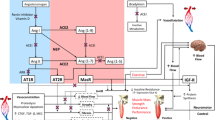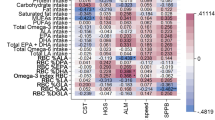Abstract
Background
Pharmacological options for the treatment of sarcopenia currently do not exist. However, off-label treatment options of some established drugs have been suggested.
Objectives
The aim of this study was to assess differences in various muscle and physical performance parameters in relation to the intake of angiotensin-converting enzyme (ACE) inhibitors in a cohort of community-dwelling older people.
Methods
Eight hundred and thirty-eight participants from the Berlin Aging Study-II (BASE-II) were included. Appendicular lean mass was assessed with dual-energy X-ray absorptiometry and related to height and body mass index. Muscle strength was measured by grip strength and related to muscle mass (arm muscle quality) and functional status was assessed via the timed “Up and Go” test.
Results
Users of ACE inhibitors had higher lean mass related to height but significantly lower lean mass related to body mass index (p = 0.001 for women and p < 0.0001 for men). Moreover, they exhibited lower arm muscle quality (p = 0.032 for women and p = 0.031 for men) and reported difficulties in climbing stairs more often than non-users (p = 0.014 for women and p = 0.004 for men). After adjustment for confounders, there were no significant differences regarding lean mass, arm muscle quality and the timed “Up and Go” test according to the use of ACE inhibitors.
Conclusions
In BASE-II, no positive relationship was found between the intake of ACE inhibitors and lean mass, strength, muscle quality or function. Moreover, remarkable differences between parameters of absolute and relative lean mass in relation to the use of ACE inhibitors became evident. Fat mass proved to be an important confounder and therefore muscle mass cannot be viewed irrespectively of whole body composition.
Similar content being viewed by others
References
Cruz-Jentoft AJ, Baeyens JP, Bauer JM, et al. Sarcopenia: European Consensus on Definition and Diagnosis. Report of the European Working Group on Sarcopenia in Older People. Age Ageing. 2010;39(4):412–23.
Janssen HC, Emmelot-Vonk MH, Verhaar HJ, et al. Determinants of vitamin D status in healthy men and women aged 40–80 years. Maturitas. 2013;74:79–83.
Fielding RA, Vellas B, Evans WJ, et al. Sarcopenia: an undiagnosed condition in older adults. Current consensus definition: prevalence, etiology, and consequences. International Working Group on Sarcopenia. J Am Med Dir Assoc. 2011;12(4):249–56.
Rolland Y, Onder G, Morley JE, et al. Current and future pharmacologic treatment of sarcopenia. Clin Geriatr Med. 2011;27(3):423–47.
Garg R, Yusuf S, Bussmann WD. Overview of randomized trials of angiotensin-converting enzyme inhibitors on mortality and morbidity in patients with heart failure. JAMA. 1995;273(18):1450–6.
Parmley WW. Evolution of angiotensin-converting enzyme inhibition in hypertension, heart failure, and vascular protection. Am J Med. 1998;105(1A):27S–31S.
Onder G, Vedova CD, Pahor M. Effects of ACE inhibitors on skeletal muscle. Curr Pharm Des. 2006;12(16):2057–64.
Sumukadas D, Witham MD, Struthers AD, et al. ACE inhibitors as a therapy for sarcopenia: evidence and possible mechanisms. J Nutr Health Aging. 2008;12(7):480–5.
Di Bari M, van de Poll-Franse LV, Onder G, et al. Antihypertensive medications and differences in muscle mass in older persons: the Health, Aging and Body Composition Study. J Am Geriatr Soc. 2004;52(6):961–6.
Onder G, Penninx BW, Balkrishnan R, et al. Relation between use of angiotensin-converting enzyme inhibitors and muscle strength and physical function in older women: an observational study. Lancet. 2002;359(9310):926–30.
Schaufelberger M, Andersson G, Eriksson BO, et al. Skeletal muscle changes in patients with chronic heart failure before and after treatment with enalapril. Eur Heart J. 1996;17(11):1678–85.
Cesari M, Pedone C, Incalci RA, et al. ACE-inhibition and physical function: results from the Trial of Angiotensin-Converting Enzyme Inhibition and Novel Cardiovascular Risk Factors (TRAIN) study. J Am Med Dir Assoc. 2010;11(1):26–32.
Sumukadas D, Witham MD, Struthers AD, et al. Effect of perindopril on physical function in elderly people with functional impairment: a randomized controlled trial. Can Med Assoc J. 2007;177(8):867–74.
Sumukadas D, Band M, Miller S, et al. Do ACE inhibitors improve the response to exercise training in functionally impaired older adults? A randomized controlled trial. J Gerontol A Biol Sci Med Sci. 2014;69(6):736–43.
McLean RR, Shardell MD, Alley DE, et al. Criteria for clinically relevant weakness and low lean mass and their longitudinal association with incident mobility impairment and mortality: the Foundation for the National Institutes of Health (FNIH) Sarcopenia Project. J Gerontol A Biol Sci Med Sci. 2014;69(5):576–83.
Bertram L, Böckenhoff A, Demuth I, et al. Cohort profile: the Berlin Aging Study II (BASE-II). Int J Epidemiol. 2014;43(3):703–12.
Baumgartner RN, Koehler KM, Gallagher D, et al. Epidemiology of sarcopenia among the elderly in New Mexico. Am J Epidemiol. 1998;147(8):755–63.
Cawthon PM, Peters KW, Shardell MD, et al. Cutpoints for low appendicular lean mass that identify older adults with clinically significant weakness. J Gerontol A Biol Sci Med Sci. 2014;69(5):567–75.
Fried LP, Tangen CM, Walston J, et al. Frailty in older adults: evidence for a phenotype. J Gerontol A Biol Sci Med Sci. 2001;56(3):M146–57.
Park SW, Goodpaster BH, Strotmeyer ES, et al. Decreased muscle strength and quality in older adults with type 2 diabetes: the Health, Aging, and Body Composition Study. Diabetes. 2006;55(6):1813–8.
Podsiadlo D, Richardson S. The timed “Up & Go”: a test of basic functional mobility for frail elderly persons. J Am Geriatr Soc. 1991;39(2):142–8.
Charlson ME, Pompei P, Ales KL, et al. A new method of classifying prognostic comorbidity in longitudinal studies: development and validation. J Chronic Dis. 1987;40(5):373–83.
Gerstorf D, Hulur G, Drewelies J, et al. Secular changes in late-life cognition and well-being: towards a long bright future with a short brisk ending? Psychol Aging. 2015;30(2):301–10.
Estrada M, Kleppinger A, Judge JO, et al. Functional impact of relative versus absolute sarcopenia in healthy older women. J Am Geriatr Soc. 2007;55(11):1712–9.
Bijlsma AY, Meskers CGM, van den Eshof N, et al. Diagnostic criteria for sarcopenia and physical performance. Age. 2014;36(1):275–85.
Spira D, Buchmann N, Nikolov J, et al. Association of low lean mass with frailty and physical performance: a comparison between two operational definitions of sarcopenia. Data from the Berlin Aging Study II (BASE-II). J Gerontol A Biol Sci Med Sci. 2015;70(6):779–84.
Sternfeld B, Ngo L, Satariano WA, et al. Associations of body composition with physical performance and self-reported functional limitation in elderly men and women. Am J Epidemiol. 2002;156(2):110–21.
Dufour AB, Hannan MT, Murabito JM, et al. Sarcopenia definitions considering body size and fat mass are associated with mobility limitations: the Framingham Study. J Gerontol A Biol Sci Med Sci. 2013;68(2):168–74.
Anker SD, Negassa A, Coats AJ, et al. Prognostic importance of weight loss in chronic heart failure and the effect of treatment with angiotensin-converting enzyme inhibitors: an observational study. Lancet. 2003;361(9363):1077–83.
Gray SL, Aragaki AK, LaMonte MJ, et al. Statins, angiotensin-converting enzyme inhibitors, and physical performance in older women. J Am Geriatr Soc. 2012;60(12):2206–14.
Witham MD, Syddall HE, Dennison E, et al. ACE inhibitors, statins and thiazides: no association with change in grip strength among community dwelling older men and women from the Hertfordshire Cohort Study. Age Ageing. 2014;43(5):661–6.
Zhou Ls Xu, Lj Wang XQ, et al. Effect of angiotensin-converting enzyme inhibitors on physical function in elderly subjects: a systematic review and meta-analysis. Drugs Aging. 2015;32(9):727–35.
Farquharson CAJ, Struthers AD. Gradual reactivation over time of vascular tissue angiotensin I to angiotensin II conversion during chronic lisinopril therapy in chronic heart failure. J Am Coll Cardiol. 2002;39(5):767–75.
Cichello SA, Weisinger RS, Schuijers J, et al. 1-Sarcosine-angiotensin II infusion effects on food intake, weight loss, energy expenditure, and skeletal muscle UCP3 gene expression in a rat model. J Cachexia Sarcopenia Muscle. 2014;5(3):239–46.
Brink M, Price SR, Chrast J, et al. Angiotensin II induces skeletal muscle wasting through enhanced protein degradation and down-regulates autocrine insulin-like growth factor I. Endocrinology. 2001;142(4):1489–96.
Sumukadas D, Struthers AD, McMurdo MET. Sarcopenia: a potential target for angiotensin-converting enzyme inhibition? Gerontology. 2006;52(4):237–42.
Author information
Authors and Affiliations
Corresponding author
Ethics declarations
Funding
This study was supported by the German Federal Ministry of Education and Research under Grant No. 16SV5536 K. Responsibility for the contents of this publication lies with the authors.
Conflict of interest
Dominik Spira, Jeremy Walston, Nikolaus Buchmann, Jivko Nikolov, Ilja Demuth, Elisabeth Steinhagen-Thiessen, Rahel Eckardt and Kristina Norman declare they have no conflicts of interest with the content of this study.
Ethical Approval
This study was approved by the Ethics Committee of the Charité-Universitätsmedizin Berlin (Approval No. EA2/029/09) and registered with the clinical trial registry Deutsches Register Klinischer Studien (DRKS00009277).
Rights and permissions
About this article
Cite this article
Spira, D., Walston, J., Buchmann, N. et al. Angiotensin-Converting Enzyme Inhibitors and Parameters of Sarcopenia: Relation to Muscle Mass, Strength and Function: Data from the Berlin Aging Study-II (BASE-II). Drugs Aging 33, 829–837 (2016). https://doi.org/10.1007/s40266-016-0396-8
Published:
Issue Date:
DOI: https://doi.org/10.1007/s40266-016-0396-8




